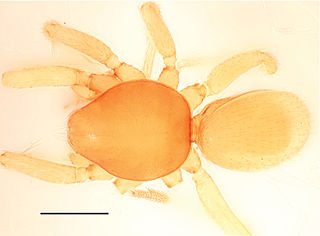
Ground spiders comprise Gnaphosidae, the seventh largest spider family with over 2,000 described species in over 100 genera distributed worldwide. There are 105 species known to central Europe, and common genera include Gnaphosa, Drassodes, Micaria, Cesonia, Zelotes and many others. They are closely related to Clubionidae. At present, no ground spiders are known to be seriously venomous to humans.

Oonopidae, also known as goblin spiders, is a family of spiders consisting of over 1,600 described species in about 113 genera worldwide, with total species diversity estimated at 2000 to 2500 species. The type genus of the family is OonopsKeyserling, 1835.
Troglohyphantes is a genus of sheet weavers that was first described by G. Joseph in 1881. The genus name is a combination of the Ancient Greek τρώγλη, meaning "cave (dweller)", and -hyphantes, a common ending for linyphiid genera.

Bannana is a genus of goblin spiders native to Xishuangbanna prefecture, Yunnan Province, China, where it lives in the leaf-litter of tropical rainforest. There are two known species: Bannana crassispina and B. parvula, both described in 2015. Individuals are pale yellow and unpatterned, and range from around 1.0 to 1.8 mm in body length, with females being slightly larger than males. The eyes are reduced or entirely absent. Known only from a nature reserve in Xishuangbanna, Bannana belongs to a group of Asian goblin spiders known as the "Dysderoides complex", that ranges from China to Pakistan and south to Indonesia.
Aprusia is a genus of goblin spiders in the family Oonopidae, containing eight accepted species. seven species are endemic to Sri Lanka and the other species is endemic to India.
Aprusia kataragama is a species of spider of the genus Aprusia. It is endemic to Sri Lanka.
Aprusia veddah, is a species of oonopid spider of the genus Aprusia. It is endemic to Sri Lanka.
Andoharano is a genus of African crevice weavers that was first described by Pekka T. Lehtinen in 1967.
Birabenella is a genus of spiders in the family Oonopidae. It was first described in 2010 by Grismado.
Blanioonops is a genus of spiders in the family Oonopidae. It was first described in 1922 by Simon & Fage. As of 2016, it contains only one species, Blanioonops patellaris, found in East Africa.
Camptoscaphiella is a genus of spiders in the family Oonopidae. It was first described in 1934 by Caporiacco. As of 2017, it contains 18 Asian species.
Neotrops is a genus of spiders in the family Oonopidae. It was first described in 2013 by Grismado & Ramírez. As of 2017, it contains 28 species.
Trilacuna is a genus of goblin spiders native to Southeast Asia, first described by Tong & Li in 2007. They look similar to members of Silhouettella, but males can be distinguished by their large palpal femur, among several other more complicated defining features. The name is a combination of the Latin terms "tri" and "lacuna", referring to the three-branched endites in males and the three-notched labium in females.

Xyphinus is a genus of goblin spiders that was first described by Eugène Louis Simon in 1893.
Himalayana is a genus of spiders in the family Oonopidae. It was first described in 2014 by Grismado. As of 2017, it contains 6 species from India and Nepal.
Gradunguloonops is a genus of spiders in the family Oonopidae. It was first described in 2015 by Grismado et al.. As of 2017, it contains 12 South American species.
Shuqiang Li is a Chinese arachnologist and a professor at the Institute of Zoology of the Chinese Academy of Sciences. Li is best known for his work with spiders and has described hundreds of new species and many genera. He is Editor in Chief of the journal Zoological Systematics.



